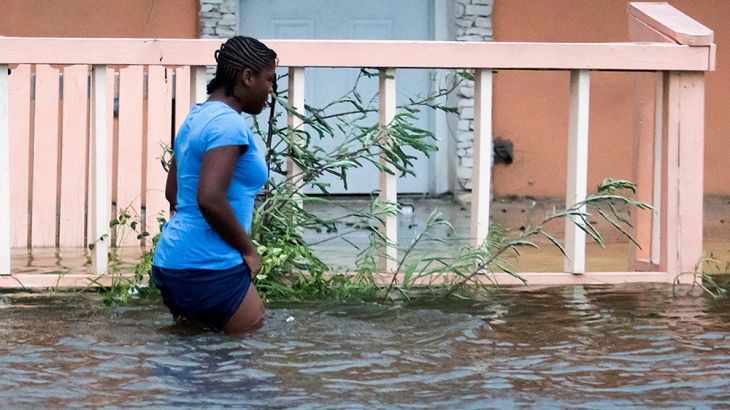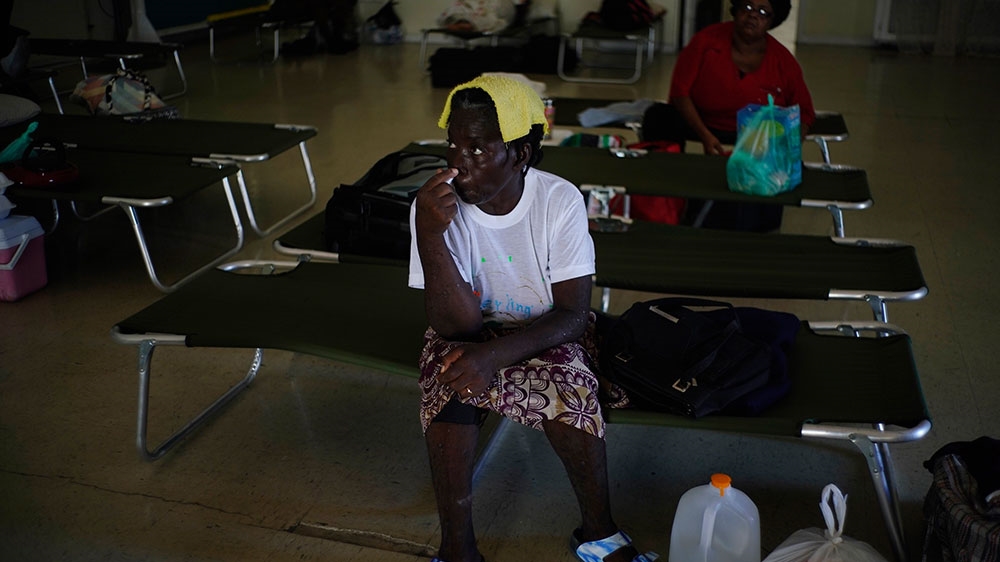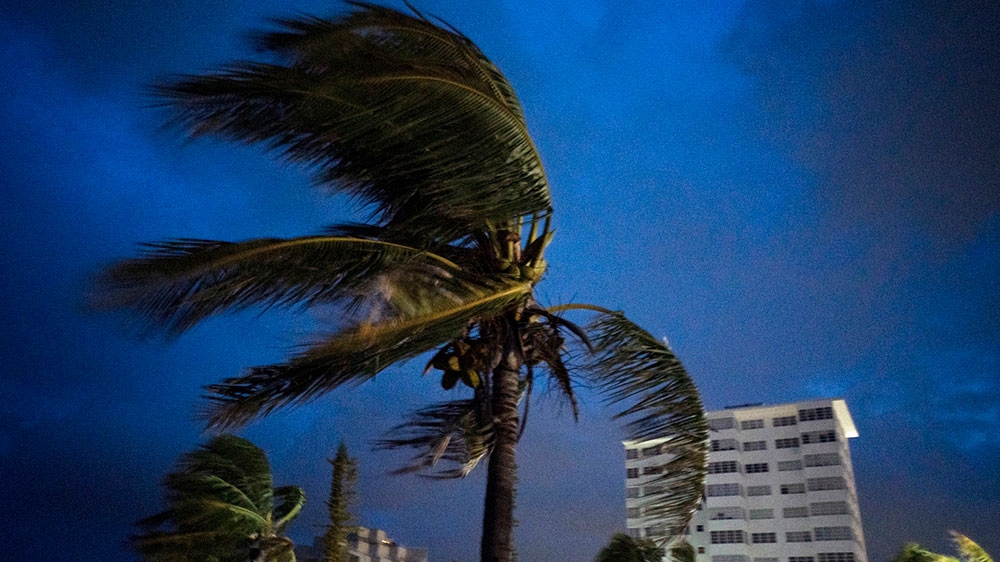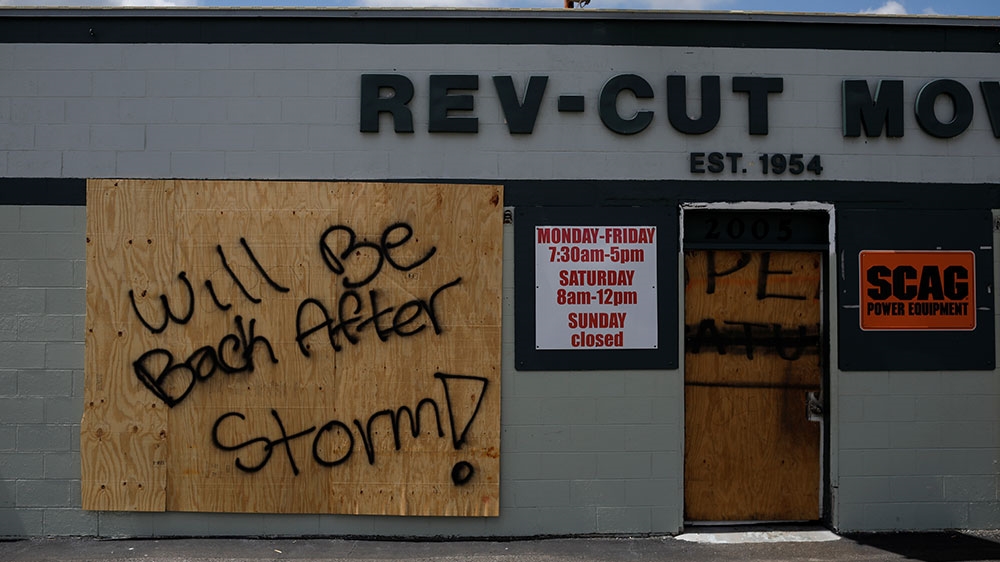Deadly Hurricane Dorian batters the Bahamas, edges closer to US
Hurricane downgraded to Category 4 but remains life-threatening, bringing winds of up to 230km an hour.

Hurricane Dorian, one of the most powerful storms ever to hit the Atlantic, continued to pummel the Bahamas, leaving a deadly path of destruction despite weakening slightly.
Dorian was downgraded to a Category 3 hurricane early on Tuesday but continues to batter the Bahamas as it remains almost at a standstill.
Keep reading
list of 4 itemsPhotos: Dubai reels from flood chaos as record rains lash UAE
Dubai submerged in floods as UAE gets over a year’s worth of rain in hours
Heavy rains kill 18 in Oman as flash floods lash UAE
Bahamas Prime Minister Hubert Minnis said at least five people had died as a result of the storm, but officials said the death toll could go up.
“We are in the midst of a historic tragedy,” Prime Minister Minnis said when announcing the fatalities. He called the devastation “unprecedented and extensive”.
Officials said they had received a “tremendous” number of calls from people in flooded homes.
A radio station received more than 2,000 distress messages, including reports of a five-month-old baby stranded on a roof and a grandmother with six grandchildren who cut a hole in the roof to escape rising floodwaters. Other reports involved a group of eight children and five adults stranded on a highway and two storm shelters that flooded.
Police Chief Samuel Butler urged people to remain calm and share their GPS coordinates, but he said rescue crews had to wait until weather conditions improved.
“We simply cannot get to you,” he told Bahamas radio station ZNS, as forecasters warned that Dorian could generate a storm surge as high as seven meters.
Residents were warned not to leave shelters until the eye of the hurricane passed. The storm’s strongest winds are usually close to the eye.
As many as 13,000 homes in the Bahamas may have been destroyed or severely damaged, the International Federation of Red Cross and Red Crescent Societies said.
“We know that there is about 75,000 people that do reside in the affected area, and many of them did evacuate, but we estimate that at least 20,000 people are going to be severely affected,” Stephen McAndrew, from the American Red Cross told Al Jazeera.
“We [also] have concerns around the water supplies…and shelters,” he added.

Houses in a neighbourhood in Freeport on Grand Bahama Island were engulfed by 1.8 metres of water. “It looks like they’re boats on top of the water,” said Rosa Knowles-Bain, 61, a resident who fled two days ago to an emergency shelter.
A Reuters witness staying at a resort on the island of Great Abaco said winds tore off the shutters and part of the roof, and the site was surrounded by a lake of water.
The hurricane, which was downgraded late Monday morning to Category 4 on the five-step Saffir-Simpson Wind Scale, remained over Grand Bahama, although the maximum sustained winds had fallen slightly to about 130 miles an hour (220 km/h) by 11pm (03:00GMT), the NHC said.
It did not expect Dorian to move far from its position over Grand Bahama during the night.
On Sunday, Dorian’s maximum sustained winds reached 185 mph (297 km/h), with gusts up to 220 mph (354 km/h), tying the record for the most powerful Atlantic hurricane ever to make landfall.

In the United States, strong gusts and high surf were already being reported along Florida’s east coast as the hurricane was about 105 miles (170km) from West Palm Beach, the centre said.
It added that Dorian would come dangerously close to the state from Monday night until Wednesday evening, then move close to the coasts of Georgia and South Carolina on Wednesday night and Thursday.
At the White House, staff members reviewed hurricane planning with state and local officials. US President Donald Trump was being briefed hourly, White House spokeswoman Stephanie Grisham said.
Mandatory evacuations, airport close
Nine counties in Florida have issued mandatory evacuations. These included for parts of Duval County, home to Jacksonville, one of Florida’s two biggest cities, and some areas in Palm Beach County, home to Trump’s Mar-a-Lago resort.
Florida Governor Ron DeSantis urged coastal residents to heed evacuation orders. “Get out now while there’s time and while you have fuel available,” he said in a news conference from the state’s emergency operations centre in Tallahassee.
Among those being evacuated was Sue Watson, a 93-year-old resident of a retirement community in Kissimmee in central Florida.
“I was all set to stay home until they had to turn the water off,” said Watson, who added that she was not worried for her personal safety but hoped the storm spared the retirement community.
The storm was causing havoc for travellers on Florida’s east coast, where some airports and petrol stations were closed.
Delta Air Lines said it cancelled 55 flights scheduled for Monday and Tuesday after airports in Fort Lauderdale, West Palm Beach, Melbourne and Daytona Beach closed.
American Airlines said operations had been suspended at seven airports in Florida and the Bahamas, and a travel alert issued for more than 20 airports including in Georgia, North Carolina and South Carolina.

South Carolina Governor Henry McMaster ordered mandatory evacuations for parts of eight coastal counties effective from noon on Monday. More than 830,000 people were under evacuation orders in Charleston and other coastal communities in the state, emergency management officials announced.
Georgia Governor Brian Kemp ordered evacuations in six coastal counties, including all of Savannah’s 150,000 residents, also effective at noon on Monday, Kemp’s office said on Twitter.
Dorian was tied with Gilbert (1988), Wilma (2005) and the 1935 Labor Day hurricane for the second-strongest Atlantic hurricane on record, based on maximum sustained winds. Allen in 1980 was the most powerful, the NHC said.
Scientists have warned that climate change is making hurricanes more intense. As global warming raises the ocean surface temperature, storms gather more energy, which can lead to greater rainfall and stronger winds as they make landfall.
“When scientists put the pieces together, they project that in general, hurricanes will become more intense in a warming world … much like we’ve seen recently with Hurricanes Harvey, Michael and Florence,” the Union of Concerned Scientists, a nonprofit science advocacy group, said in a blog post about Hurricane Dorian.